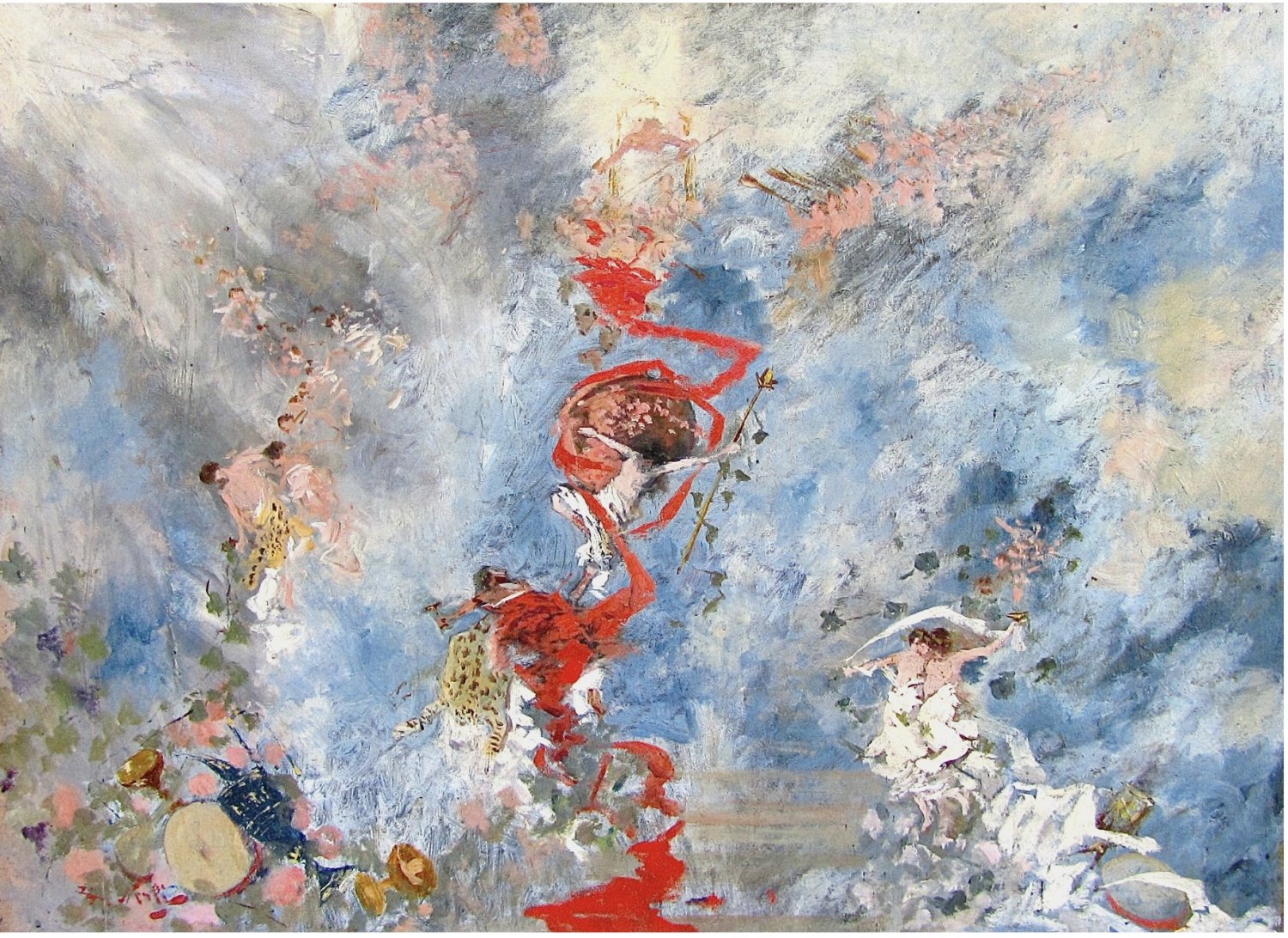Girolamo Pieri Ballati Nerli
The Ascension
oil on canvas
signed lower left on the reverse of the canvas is a caricature sketch (approximately 8 cm high) in black ink (presumably a self portrait by Nerli). Inscribed verso (below sketch): ‘Snr Nerli two year without opium’. The canvas has a Windsor & Newton stamp on the reverse.
SOLD
Provenance:
The artist (the painting was in the artist’s studio in Norwich Chambers, Hunter Street, Sydney – it can be seen in Nerli’s studio painting titled The Sitting now in the Queensland Art Gallery); probably taken by Nerli to Dunedin, New Zealand; unknown (presumably owned by the person to whom the inscription on the reverse of painting was written. The inscription is reproduced below); Cordy’s (auction house), Auckland, NZ, lot 199, March 1971; Mr A. Williams, Auckland NZ (collector who purchased the painting from Cordy’s auction - a copy of receipt attached to the reverse of the painting); Art & Object (auction, Auckland, NZ), lot 125, August, 2013; private collection of Jim Berry and Stephen Scheding, Sydney, and gifted by them to The Queensland Art Gallery and Gallery of Modern Art.
Literature:
Illustrated: in colour (opp. p48) and in black & white (p106) in Peter Entwisle, Michael Dunn and Roger Collins, Nerli: An exhibition of paintings and drawings, Dunedin Public Art Gallery, 1988.
References: Peter Entwisle, Michael Dunn and Roger Collins, Nerli: An exhibition of paintings and drawings, Dunedin Public Art Gallery, 1988. This includes a catalogue raisonné in which The Ascension is catalogue no. 25 (pp. 107 – 108); There is a reference to The Ascension in the essay on Nerli’s The Sitting in Brought to Light, Queensland Art Gallery, 1998, p64 and endnote 8, p303; Art & Object catalogue, 2013, essay on The Ascension by Michael Dunn.
In 2013, Nerli’s The Ascension re-emerged after decades of its whereabouts being a mystery. In the 1988 publication Nerli: An exhibition of paintings and drawings by Entwistle, et al, it was stated that The Ascension was (ie in 1988) was ‘known only from a large colour transparency in the Auckland City Art Gallery’. (This transparency was presumably used to reproduced The Ascension in the 1988 monograph).
Entwistle, et al, give the date of Ascension as c1887 and suggest as a provenance: ‘Perhaps once owned by Chales Conder in Melbourne in 1888’. However, given that the painting ‘surfaced’ in New Zealand it is more probable that it was kept by Nerli and sold or gifted when Nerli was in New Zealand in 1889 or from 1892 - 1898. There is still mystery regarding the whereabouts of the painting from the time it left Nerli’s possession until it was offered at auction in Auckland in 1971. One possibility is that it went to New Zealand artist and patron William Mathew Hodgkins prior to his death in 1898 (see below).
Peter Entwistle, in Nerli: An exhibition of paintings and drawings, writes of The Ascension: ‘Because of its freedom, indeed its advance towards abstract painting – it virtually anticipates abstract expressionism by sixty years – it is one of the most remarkable paintings made in Australia last century.’ (p33). He adds that ‘The Ascension is an ‘extraordinarily daring sketch’ and that it is ‘more highly abstracted than anything this writer has seen of any of the Italian’s Australian contemporaries.’ (p34-8).
In the catalogue raisonné of Entwistle, et al, there is a description of The Ascension as ‘the mysterious and important painting [which has] a number of the same motifs [as the ‘orgia’ or bacchanalian paintings]: the leopard skin; semi-draped heavenly hosts doing duty for the reveling orgiasts; the red banner now a kind of scarlet streamer, floating down from the heights of paradise.’ (p105).
The catalogue raisonné of Entwistle, et al, further points out that The Ascension appears in Nerli’s ‘great costume piece’, The Sitting, hanging on the wall in the background above the sitters’s head) and adds that it is ‘an unusual act of self-reference for a nineteenth-century Australian artist.’ (Pages 108 and 117). They date The Sitting as 1889 and add that ‘that tends to confirm the date suggested here [ie c1887 for The Ascension].’
Entwistle, et al, suggest that with its ‘free execution… the leopard skins and the semi-draped heavenly hosts which resemble bacchanalian revellers’ The Ascension has a close relationship to Nerli’s Orgiapaintings, and ‘presumably it is of about the same date’. One of Nerli’s ‘Orgia paintings’ titled A Bacchanalian Orgie is dated 1887 and is also inscribed ‘Sydney’. Entwistle, et al, write that Ascension ‘seems to owe something to [the influential Italian artist Adolphe] Monticelli. It is also reminiscent of some seicento [17th century] mannerist paintings, particularly those studies of apotheoses and ascensions which were made on canvases such as this for later transfer to the ceilings of grand chambers.’ (P108).
Entwistle, et al, conclude that ‘Nerli was an important influence in introducing a number of new things into Australian painting… and we know he caused a sensation by his assumption that a finished work may be very sketchy… It should probably be allowed that Nerli exerted a specific influence on Streeton, a specific and direct influence on Roberts and it really cannot be denied that he acted both specifically and directly on Conder which Conder himself freely acknowledged.’ (P 38).
Michael Dunn in his book Nerli – An Italian Painter in the South Pacific, AUP, published in 2005, refers to The Ascension as being in the background of Nerli’s The Sitting. However, at the time this book was published Dunn, who had been a co-author of the 1988 book Nerli: An exhibition of paintings and drawings, had still not seen the original painting which had been hidden in a private collection and was known only by the colour transparency in the Auckland City Art Gallery. On seeing the original in 2013 Dunn wrote:
‘Giraolamo Nerli first came to public attention in Australia with a series of sketchy historical paintings, set in imperial Rome of the decadence, called his Orgia (1887 – 1889). These paintings of Roman orgies, mostly small and depicting inebriated men falling to the ground and wildly clutching at scantily clad girls, caused a scandal both for the subject matter and their technique. They showed the young Nerli, fresh out of Italy and with an academic training, letting his hair down and taking gestural brushwork to a new extreme at the expense of conventional drawing and modelling. Maybe Monticelli, a favourite painter and friend of Van Gough, was influential, as the critics said, on the expressionistic quality of these works and the related painting The Ascension. But the virtuoso brushwork slashed on with the flair of swordsmen duelling traces back to his Italian origins where famous compatriots like Giovani Boldini took Paris by storm with their flamboyant techniques and showmanship. In their hands the application of the paint and the actual strokes and dabs became a prominent part of the artwork, to be displayed not hidden.
Fittingly Nerli chose The Ascension as a centrepiece on the wall of his lavishly decorated studio in Norwich Chambers, Hunter Street, Sydney, as we can see in his large painting called The Sitting, 1889… Here it is shown on the studio wall amidst Japanese artefacts. Persian rugs, pampas grass, a Polynesian headdress and all the trappings of an aesthetic studio complete with glamorous model. He was clearly pleased enough with The Ascension to showcase it in this way knowing its appeal as a visual magnet for debate, controversy and publicity among the fashionable visitors and press who thronged through his studio. Those used to academic paintings of religious and mythological subjects found Nerli’s approach shocking but he always had his supporters.
The Ascension is less about the subject, sketchily touched in figures of an apotheosis complete with trumpeting angels and wildly gesticulating figures than a display of painterly brushwork ranging from small dabs and splotches to bold strokes and calligraphic marks, seemingly spontaneous and unrevised. The prominent red slashes of colour near the centre of the canvas, are a triumph of art over illusion where they justify their importance purely because they look good and feel right. Painted about 1887 The Ascension is a daring experimental work unlike any other of the time in Australian and New Zealand. Even today it is a joy to look at its freshness, its painterly dexterity and its expressionistic qualities. We can sense the artist at work and empathise with every move of his brush. In terms of its subject it may be flippant – and who cares. In terms of painting it is liberating and meaningful – a truly unique work that only Nerli could have painted.’
Further comments: The Ascension relates to the style of the Macchiaioli group of artists who were experimenting in Italy at the time Nerli departed. However, in this painting Nerli pushes the painterly boundaries even further, towards abstraction. The Ascension is certainly far in advance of any other work of art produced in Australia at a time already noted by art historians for advances made by the Australian Impressionists. For this reason it could be argued that The Ascension is one of the most significant paintings in Australian art.
The subject of the painting can be seen as the biblical Ascension of Jesus. Hovering above Jesus is an orchestra of heavenly angels receiving him to Heaven. This follows a liturgical text: ‘God goes up with shouts of joy/ a blare of trumpets for the Lord.’ A sense of joyousness radiates from the painting. At the top of the image Jesus is already ascended and enthroned. The vibrant red flowing down the centre of the image may represent the blood of Christ which, at the bottom of the image becomes the river of life. The painting is teeming with other symbols. Indeed, it could be possible to ‘read’ the symbols as an intertwining of both Christian and Greek mythology.
The inscription on the reverse of the painting is also one of the most extraordinary inscriptions to be written onto an Australian work of art: ‘S[ig]n[o]r Nerli two year without opium’. It is interesting to speculate on the circumstance by which this inscription came to be there. To which two years does Nerli refer? Interestingly, the years 1890 and 1891 are the least documented of his life and it may be these two years being referred to. Was The Ascension painted while under the influence of opium? Who exactly was the inscription meant for? Was the painting a gift? Who acquired it from Nerli? It would probably have been a significant person in Nerli’s life and one possibility would be Nerli’s student and later patron in Dunedin, William Mathew Hodgkins. Although there is currently no evidence for this, the possibility deserves further research.




